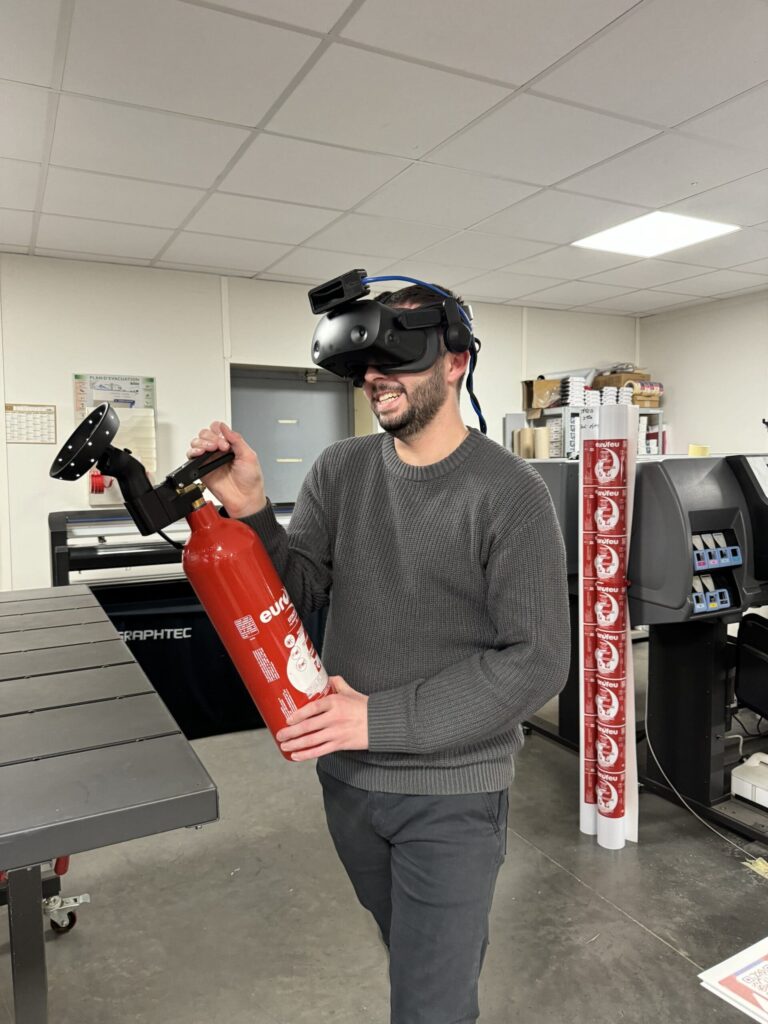Why take a fire training course?

Fire training is not only governed by the French Labor Code, it is also crucial to company safety. Its aim is to make employees aware of the risk of fire, how to behave and how to use fire-fighting equipment effectively. This training, which is compulsory in some companies, teaches vital reflexes, particularly for evacuation in the event of an emergency.
The importance of in-house fire training
Corporate fire training plays an essential role in ensuring employee safety and minimizing the consequences of a fire. Staff training significantly reduces the risk of serious accidents. Companies need to put in place appropriate training programs, which include :
- Learning evacuation procedures
- Handling fire extinguishers
- Knowledge of safety instructions
Training is not only a legal obligation, but also an investment in business continuity. Well-trained personnel can prevent fires and respond effectively to emergencies.
Take the example of a company that regularly conducts evacuation drills. In the event of a disaster, employees will react more quickly, thus limiting human and material damage. The benefits of such training are many and invaluable for collective safety.
Fire training: a legal obligation
To guarantee safety in the workplace, the French Labor Code requires regular fire training. Such training is essential to ensure that employees know how to react quickly and effectively in the event of a fire. Legal obligations include the organization of evacuation drills every six months.
In addition, companies must ensure that their personnel are proficient in the use of emergency equipment. This includes :
- Learning how to use fire extinguishers
- The implementation of clear safety instructions
- Fire alarm procedure
A company must also schedule refresher training sessions to keep skills up to date. Site managers are thus required to take all necessary measures to protect the health and safety of their employees. Failure to comply with these obligations may result in sanctions.
Fire prevention objectives
Understanding fire-related risks
When it comes to understanding fire-related hazards, it's essential to recognize the factors that trigger a fire. The fire triangle, which includes fuel, oxidizer and a source of ignition, is the basis of every fire.
There are many possible causes for a fire:
- Human carelessness, such as the inappropriate use of electrical appliances.
- The presence of improperly stored flammable materials.
- Hot-spot work.
Identifying these risks is crucial to managing them more effectively. Take, for example, a company that has properly trained its employees to handle fire extinguishers. Should a fire break out, these employees will be able to intervene quickly and effectively, reducing the potential impact on installations and people's safety. A good understanding of the risks involved means that appropriate preventive measures can be taken.
How to react to a fire
When a fire breaks out, it's essential to act quickly and methodically to limit its spread. The first step is to raise the alarm by triggering the fire alarm and contacting the emergency services, in particular the fire department.
If the fire is still controllable, use available equipment, such as a fire extinguisher, to try to put it out. Be sure to follow safety instructions and keep a safe distance to avoid any danger.
It's also crucial to know the types of extinguishers and their appropriate use according to the nature of the fire. For example, for a grease fire, it's better to smother the flames with a fire blanket than to use water, which could make the situation worse.
Finally, if the fire gets out of control, calmly evacuate the area and head for the safe assembly point.
Mastering the use of safety equipment
To use safety equipment effectively, it's essential to know what's available and how it works. A fire extinguisher, for example, must be handled with confidence if it is to be effective. Fire training courses teach you how to quickly assess the situation and choose the right extinguisher for the type of fire.
Here are a few crucial elements to master:
- The different types of extinguishers: powder, water, CO2, each adapted to specific fires.
- The sweeping technique for optimal flame extinguishing.
- Identify access points to fire hydrants in your building.
Practical training using teaching aids such as a fire tank will help you simulate realistic scenarios. By repeating these exercises, you'll develop the reflexes needed to respond quickly and effectively to a fire.
Fire training regulations
The role of the labour code
The French Labor Code plays a fundamental role in regulating fire training in the workplace. It lays down precise obligations for employers, ensuring that their employees are trained in fire safety. This training must be adapted to the specific needs of the establishment. It includes learning how to use fire extinguishers and how to organize evacuations.
Key articles, such as R4227-28, specify that the employer must take all necessary measures to effectively combat an outbreak of fire. This includes:
- Inform workers of safety instructions
- Set up an early warning system
- Organize regular evacuation drills
These measures are designed to protect the lives of employees and reduce fire-related risks. As a result, regulations require constant vigilance and regular updating of fire safety skills.
Obligations for ERP
Establishments open to the public (ERP) must comply with strict fire safety requirements. In accordance with the French Labor Code, all personnel, including temporary staff and trainees, must be trained in fire extinguisher handling and evacuation.
Fire safety training must include practical exercises to ensure an effective response in the event of an incident.
Here are a few key points to bear in mind for ERP:
- Regular training: Sessions must be recurrent to maintain vigilance.
- Safety equipment: Regular checks on equipment such as alarms and fire extinguishers.
- Evacuation plan: Regular updates and evacuation drills for all occupants.
These measures are essential to ensure the protection of users and staff, and to avoid heavy penalties in the event of non-compliance.
Criteria for compliant fire training
For a fire training course to be considered compliant, several criteria must be met. Firstly, the content of the training must be specifically adapted to the risks identified in the facility. This personalization ensures that employees are better prepared for potential hazards.
It is also essential that training sessions are led by qualified instructors with recognized expertise in the field of fire safety. These trainers must be able to convey practical and theoretical knowledge in a clear and engaging way.
Compliant training often includes practical exercises, such as using a fire extinguisher or simulating an evacuation. This enables employees to develop essential reflexes in the event of an emergency.
Finally, a training certificate, certifying attendance and acquisition of the necessary skills, is often required to validate training compliance.
The impact of fire training on corporate safety
Reducing the risk of incidents
Fire training courses can significantly reduce the risk of incidents occurring in the workplace. By raising staff awareness of best practices, they reduce risk-taking behavior.
The advantages are numerous:
- Proactive identification of potential hazards
- Implementation of appropriate safety procedures
- Training in the use of fire-fighting equipment
A concrete example is the regular assessment of electrical installations, which are often the source of fires. Companies can prevent incidents by carrying out regular checks.
Employees' responsiveness is also enhanced, enabling them to react quickly in the event of a fire outbreak. Thanks to practical exercises, employees acquire the reflexes needed to deal with an emergency situation, thus limiting material and human damage.
These measures contribute to enhanced infrastructure protection and business continuity.
Improving evacuation reflexes
Several strategies can be implemented to improve evacuation reflexes. Firstly, regular evacuation drills are essential. These simulations enable employees to familiarize themselves with the procedures to be followed, and reduce the time needed to leave the premises in the event of danger.
Identifying leaders within the team, such as guide-files and greenhouse-files, ensures effective coordination. These people are specifically trained to lead the evacuation in an orderly fashion.
It is also beneficial to use technological tools, such as augmented reality, to provide an immersive experience during exercises. This approach reinforces learning and helps anchor the right reflexes.
Finally, a debriefing after each exercise helps to identify areas for improvement, ensuring that the evacuation takes place in the best possible conditions.
Company sustainability and employee safety
Fire training is essential to a company's long-term viability, helping to reduce the risk of serious incidents. It ensures not only employee safety, but also business continuity. By training employees in the appropriate procedures, companies can reduce the consequences of a fire.
Benefits include :
- Reduced downtime: prepared employees react quickly, limiting production interruptions.
- Asset protection: appropriate procedures protect material assets.
- Enhanced reputation: a company that is proactive in terms of safety enhances its credibility with customers and partners.
The integration of a safety culture, through regular training, ensures an effective response to emergency situations. Companies that invest in fire training demonstrate their commitment to safety and sustainability.


